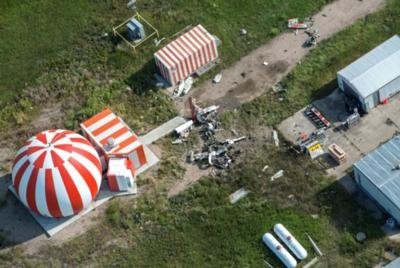Tue, Jan 09, 2018
No Mechanical Issues Found With The Airplane, Board Says
The Transportation Safety Board of Canada has released an interim report with details about an accident which occurred during the Cold Lake Air Show on July 17, 2016 resulting in the fatal injury of pilot Bruce Evans of Calgary, Alberta CA.

Evans was flying a vintage T-28 aircraft which impacted terrain at a steep nose-down attitude during his performance at the show. According to the TSB report, Evans participated in the first day of the show on July 16 without incident. During the accident flight, which began at 1340 local time, the first half of the demonstration consisted mainly of aerobatic maneuvers performed as listed in a submission to the air show operator. However, rather than a slow roll, the pilot flew what appeared to be half of a lazy eight followed by a half reverse Cuban, which was performed at show right to accomplish the reversal. It is not unusual for an aerobatic performer to modify the order of maneuvers in a routine to compensate for conditions or for positioning. Such alterations are acceptable provided that they are consistent with the maneuvers in the planned routine.
The pilot flew from show right to left at about 500 feet above ground level (AGL) within the defined airspace for the routine, then entered a roll just before show center. As the aircraft reached the inverted position, the roll stopped and the nose began to pitch toward the ground. The aircraft elevator was seen to move to full up deflection as the aircraft continued toward the ground in an arc until its collision with terrain, in a near-vertical position with a slight right roll.
The aircraft struck the ground at a high velocity, in a near-vertical attitude. It was destroyed by impact forces. The impact site was located among several structures used for provision of airfield services. These included the buildings that housed the precision approach radar equipment and its backup power generator, and twin 1000-gallon propane tanks.
All major components of the aircraft were accounted for at the accident site. Based on the examination of the wreckage, and on the information from the photographs and videos collected, it was determined that the engine and flight controls had been operating normally prior to impact.
(Image provided with TSB Report)
More News
Terminal Radar Service Area Airspace surrounding designated airports wherein ATC provides radar vectoring, sequencing, and separation on a full-time basis for all IFR and participa>[...]
Aero Linx: Utah Back Country Pilots Association (UBCP) Through the sharing experiences, the UBCP has built upon a foundation of safe operating practices in some of the most challen>[...]
From 2010 (YouTube Edition): Imagine... Be The Change... Inspire FROM 2010: One of the more unusual phone calls I have ever received occurred a few years ago... from Anousheh Ansar>[...]
(Pilot) Felt A Shudder And Heard The Engine Sounding Differently, Followed By The Engine Chip Detector Light On April 14, 2025, about 1800 Pacific daylight time, a Bell 206B, N1667>[...]
Also: AMA Names Tyler Dobbs, More Falcon 9 Ops, Firefly Launch Unsuccessful, Autonomous F-16s The Air Force has begun ground testing a future uncrewed jet design in a milestone tow>[...]
 ANN's Daily Aero-Term (05.07.25): Terminal Radar Service Area
ANN's Daily Aero-Term (05.07.25): Terminal Radar Service Area ANN's Daily Aero-Linx (05.07.25)
ANN's Daily Aero-Linx (05.07.25) Classic Aero-TV: Anousheh Ansari -- The Woman Behind The Prize
Classic Aero-TV: Anousheh Ansari -- The Woman Behind The Prize NTSB Prelim: Bell 206B
NTSB Prelim: Bell 206B Airborne-NextGen 05.06.25: AF Uncrewed Fighters, Drones v Planes, Joby Crew Test
Airborne-NextGen 05.06.25: AF Uncrewed Fighters, Drones v Planes, Joby Crew Test



